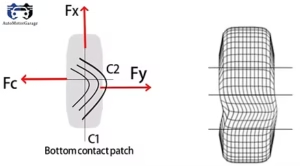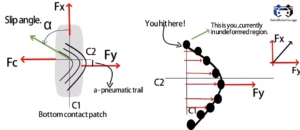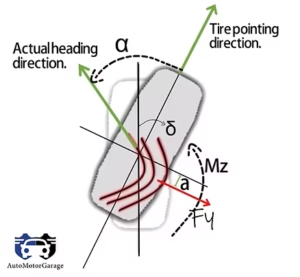
Let’s first see how lateral force is generated ?

In the above figure , you can see that when you take a right turn then the car tire experience a centrifugal or inertial force at wheel center. This inertial force Fc , tries to pull the vehicle towards left direction and to prevent this pulling a force is generated at bottom of tire in right direction , which tries to resist this pulling . The resisting force here , is shown by Fy. Fy is called the lateral force and the maximum value of Fy is given by :-
Fy = μy * W
Where μy is the coefficient of friction in y direction.
Now let’s see this case at micro level:-

Here , tire treads are shown by brush bristles. This also called the tire brush model. Now when the tire is pushed leftwards due to centrifugal force Fc , the treads on the ground get stretched and generate a tension in them. This tension developed in the tire treads is called Lateral force , shown by Fy .
When Fc > Fy , the tire will skid towards left direction.


Suppose , you are a black dot shown in the above figure, now currently you are in un-deformed region of tire. Now as the tire rolls , you hit the contact patch at first black dot position. At this point you are acted by the forward force Fx and the lateral force Fy in right direction , due to which , you will be moving in black arrow direction. This will stretch you away from the central line C2 of tire and you will move to second position of black dot , then to third and so on.
You will be stretched till the maximum value of Fy is achieved , which is generally achieved after some distance from the central line C1 . When the maximum value of Fy is achieved , now beyond this point as the tire tread is unloaded , you will get skid and move towards the plane C1 of tire and this cycles continues . This is happening with every tread of tire , due to which the tire is deformed like a curve at contact patch.
Tangent made to the tires contact patch (green arrow) , shows the actual moving direction of tire. Angle between this tangent and the direction in which tire is pointing is called Slip angle and is denoted by α .
Lateral force Fy is acting at some distance “a” from the central line C2 , and this distance is called pneumatic trail.

Now here, Fy is the lateral force generated at some distance “a” from the center. This force will produce a self aligning torque at center and will try to rotate the tire clockwise direction.
Mz – self aligning torque
When slip angle & lateral force is reduced,it will reduce the pneumatic trail “a” and will reduce the self aligning torque.